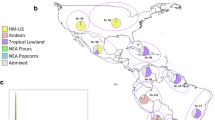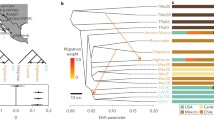Abstract.
The resolution that can be obtained from molecular genetic markers affords new prospects for understanding the dispersion of agricultural species from their primary origin centres. In order to study the introduction and the dispersion of maize in Europe, we have characterised a large and representative set of maize populations of both American and European origins for their variation at 29 restriction fragment length polymorphism loci. Polymorphism was higher for American populations than for European populations (respectively, 12.3 and 9.6 alleles per locus, on average), and only a few alleles were specific to European populations. Investigation of genetic similarity between populations from both continents made it possible to identify various types of American maize introduced into Europe at different times or in different places and which have given rise to distinctive European races. Beyond confirming the importance of Caribbean germplasm, the first maize type to be introduced into Europe, this research revealed that introductions of Northern American flint populations have played a key role in the adaptation of maize to the European climate. According to a detailed historical investigation, the introduction of these populations must have occurred shortly after the discovery of the New World.
Similar content being viewed by others
Author information
Authors and Affiliations
Additional information
Electronic Publication
Rights and permissions
About this article
Cite this article
Rebourg, .C., Chastanet, .M., Gouesnard, .B. et al. Maize introduction into Europe: the history reviewed in the light of molecular data. Theor Appl Genet 106, 895–903 (2003). https://doi.org/10.1007/s00122-002-1140-9
Received:
Accepted:
Issue Date:
DOI: https://doi.org/10.1007/s00122-002-1140-9




